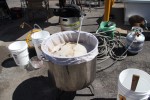Welcome back, folks. This time around, let’s talk about big beers. Many people think of high gravity beers as the sole province of winter, and there are some delectable examples that appear every cold season, but the savvy drinker can enjoy them year round. I presume if you are into the beer culture enough to be reading this, you have probably gotten past the whole “dark = big” falsehood that seems to be so prominent among amateur beer-folk, so let’s define what we really mean by the phrase “high gravity”. Gravity in this context really refers to a measurement of “specific gravity”. Actually a measure of density rather than mass, specific gravity effectively tells a brewer how much sugar is in the wort pre-fermentation. As yeast eat sugar to produce alcohol, the gravity goes down. Some brief calculations based on known metabolic rates will then tell us how much alcohol is in a beer based on how much sugar was eaten. Given those facts, “high gravity” really just means it started with a bunch of sugar. A poor fermentation could certainly leave a “high gravity” beer that has 3% alcohol and is super-sweet, but that sounds repulsive. Much of this article will be about how to avoid that.
Because “high” is a pretty subjective term, let’s get a little more specific. For the purposes of our discussion, I’m going to call any beer that starts with a specific gravity of 20 degrees Plato or higher “high gravity”. At an optimistic but achievable attenuation of 75% that will yield an ABV of 8.4%. Not giant by today’s standards but high enough to set the bottom limit of the term. Now that we know what high gravity beer is, let’s explore what I view as the three key hurdles to making it: 1) how to get enough sugar into your wort, 2) how to make sure your sugar ferments, and 3) how to keep it from tasting like shit. Those last two points are very heavily intertwined and will be handled largely as one point.
By far the most prominent way for brewers to get sugar into their wort is by the process of mashing grains (mostly barley). This is, in my opinion, the best method, but it does come with some challenges if you are going to use it exclusively. First, you are limited by the size of your mash tun. Many brewers have mash tuns that are scaled to be able to produce a certain range of specific gravities for the volume for the volume of their boil kettle. You can only use as much grain as your mash tun will hold. One way of getting around this limitation is to double mash. By this process a brewer can fill up a mash tun, take the first runnings (or more concentrated wort) without sparging too much, then dump the tun and do it again. This allows you to effectively double the volume of first runnings you get but does mean that you have to sacrifice the rest of the sugar you would normally collect by sparging. Essentially you sacrifice efficiency for a greater sugar concentration. The second common method for getting more sugar into wort is simply adding it after the mash. There are a variety of sugars that can be added in the form of syrups and solids, but many of them do come with a certain stigma in the brewing world. Liquid malt extract can be used (like in simple homebrewing) to add sugars that are similar in chemical makeup to the wort you already collected. Other natural sugar liquids such as honey, molasses, agave, and maple syrup as well as solids such as dextrose, lactose, candi sugar, and even table sugar can give a boost to total sugar, but some care must be taken. Beer yeast is designed to ferment the particular blend of sugars that come from malting barley. Other sugar sources may be more or less fermentable, may not have all of the required ancillary nutrients, and may produce unusual flavors. You have been warned.
After we have a wort with sufficient sugar concentration, our next step is to turn that sugar into alcohol. Since this job will be done by our yeast, it is our responsibility to make the job as manageable as possible. This involves pitching a large enough army of the right strain to get the job done and making sure they have the tools necessary to ferment.
Your authentic traditional hand-cultured British basement strain may produce some exquisite esters, but if it craps out at 6% alcohol then it isn’t the strain for this project. Ideally you want to locate a strain that can survive a good deal beyond your target ABV. As the yeast approach their alcohol toleration limit, they sometimes act unpredictably, so it’s best to have something that will survive several percentage points beyond what you are actually making. Many Belgian strains tend to be good at this, but always check the details of your yeast before starting a project like this. You also need to make sure you pitch enough viable cells. I won’t get into cell count here, but you can find calculators for how much of your chosen format you need to get though a certain amount of sugar. Hint: you may need more than that one tube or smack pack.
Lastly, you need to make sure that conditions are right for your yeast to do their job without mutating or getting stuck. Your first key is aeration. Make sure the yeast have enough oxygen in the fresh wort to perform all their cellular replications. If you aerate with atmospheric air, you will have trouble getting enough oxygen in solution for truly huge beers, but should still be able to make beers within our definition. With pure oxygen aeration, your range goes up considerably. With extremely high gravity beers, you may even need to supplement your aeration about 12 hours after pitching. The oxygen saturation point may be below the yeast’s actual needs, so a second dose after they have started to utilize a good portion of the first dose can help get them where they need to go. Some yeast nutrients may also be a good idea, especially if you have gotten a significant portion of your sugars from sources other than malted barley, which naturally contains just about everything yeast need to perform. Temperature can also play a big role in making sure that the sugar gets metabolized and that the right flavors are formed. Start your fermentation at the high end of its recommended temperature range, and after fermentation has peaked (high krauzen), allow the temperature to float up a couple more degrees to keep the yeast aggressive for those last few points.
Well, that should be enough to get you going on some high gravity beasts. If you make any you like, bring me a bottle and tell me what you did. Until next time, faithful readers, thanks for reading, and happy drinks!
P.S. Remember to let me know if you have some specific topic you would like me to babble about next time. You can tell me in person, by e-mail, or in the comments right down below.






